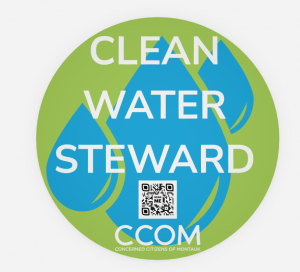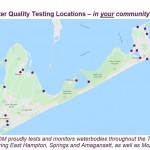IMPROVING Water Quality
Water is the lifeblood of Montauk. It defines who we are as a community. In fact, Montauk has 23 bodies of water – some of which are threatened. To ensure the health of our water bodies, we have introduced and continue to sustain multiple water quality programs and initiatives.
CURRENT IMPROVEMENT PROJECTS
save montauk’s waters campaign | become a clean water steward
We need you, our community, to help Save Montauk’s Waters. It’s simple: pledge to take 1 or more of 10 easy, impactful Practices for Clean Water to reduce pollution—and CCOM supports you every step of the way. Take the pledge and sign up to become a Clean Water Steward!
As a Thank You: Stop by the CCOM office to pick up your “Clean Water Steward” yard sign!
Clean Water Steward Pledge: 10 Practices for Clean Water (Choose 1 or more)
✅ Use organic fertilizer—or none at all
✅ Plant native trees, flowers, and shrubs
✅ Upgrade to an I/A septic system or pump out my septic/cesspool
✅ Leave grass clippings on the lawn and bag leaves
✅ Always pick up my pet’s waste, even in my yard
✅ Increase permeable ground around my home
✅ Set mower height at 3.5 inches or taller
✅ Redirect downspouts into garden beds
✅ Use a commercial car wash instead of washing at home
✅ Add a rain barrel to my yard or garden
Bonus: Spread the word to a neighbor!
Actions developed in accordance with the NYS Department of Environmental Conservation Long Island Nitrogen Action Plan.
our septic problem: basics and why to upgrade
Outdated cesspools and septic systems across Suffolk County are a leading cause of nitrogen pollution, contaminating groundwater, fueling harmful algal blooms, and harming our coastal waters. Upgrading to a modern, low-nitrogen system protects water quality—and grants and incentives can cover up to 100% of your upgrade cost.
Start by identifying the age and type of your current system, then explore the Town, County, and State programs below to find financial assistance and qualified professionals to guide your upgrade.
Learn more:
- Wastewater System Basics and the Pollution Problem – The Nature Conservancy
- The Impacts of Nitrogen on Long Island Waters – NYS Department of Environmental Conservation
- Nitrogen Pollution from Old Wastewater Systems on Long Island (news coverage) – New York Sea Grant
- Typical Septic System Components and Maintenance – NYS Department of Health
Septic Upgrade information
CCOM Septic Improvement Application Assistance
Through a partnership with Suffolk County’s Reclaim Our Water program and generous support from New York Community Trust, we have been assisting community members through the process of upgrading their outdated cesspools and septic systems to new nitrogen-reducing technologies. Wherever you are in the process, we are here to help you!
Grant Funding
Through a Town of East Hampton Septic Improvement Program application paired with a joint New York State and Suffolk County Septic Improvement Program application, you may be eligible to receive up to $55,000 in grant funding toward your upgrade — potentially covering 100% of the installation cost of your new system. Find more information about these two application processes below:
- The Town of East Hampton Septic Incentive Program
Residential and commercial property owners may be eligible to receive the Town’s new modified grant / rebate to upgrade to an approved low nitrogen system – up to $20,000 if your property is located within the Water Protection District or if you qualify for low-moderate income, and up to $15,000 if your property is located outside of the Water Protection District.
- Town of East Hampton Septic Incentive Program
- Water Protection District Map (type in your address to see if your property is located in the water protection district).
For additional Town assistance, contact the Town of East Hampton Natural Resources Department
IMPORTANT! As of December 2022, Septic upgrade grants are no longer considered taxable income. If you have already upgraded and were taxed, you are entitled to a reimbursement. We suggest you contact your accountant about an income adjustment.
- Suffolk County Septic Improvement Program Grant
Grants are currently available for up to $20,000 for eligible homeowners, plus up to an additional $10,000 from New York State.
- Suffolk County Septic Improvement Program Information
- Understanding the Grant Process
- Informational Presentation, 2025
Community Development of Long Island
Community Development of Long Island (CDLI) is a nonprofit that offers an additional loan program to help finance septic system upgrades. CDLI provides “gap” funds up to $10,000 to finance the difference between the grant provided by Suffolk County and the contract amount needed to install the septic replacement system.
WATER MONITORING PROGRAMS
Over the past several years we have introduced and sustained multiple scientifically based water quality testing initiatives not just in Montauk, but throughout East Hampton Town. Our ongoing water testing is critical to water quality improvement efforts; it provides the data needed to assess current conditions, and to monitor and track the impacts and effectiveness of new projects.
Enterococcus is a bacteria that exists in the guts of warm-blooded animals (birds, humans, and other mammals). Out of concern for declining water quality, CCOM joined Surfrider Foundation’s nationwide Blue Water Task Force in 2013 to start testing enterococcus bacteria levels in Montauk’s waters. Since then, CCOM staff and volunteers have expanded the program and now work year-round collecting water samples in Montauk, Amagansett, and East Hampton, and performing bacterial analysis right in our office lab. On average, during the summer months, we process 30 water samples per week! Sharing our data with the Blue Water Task Force ensures broader outreach and greater environmental and public health.
HARMFUL ALGAL BLOOM (HAB)
In May 2018 CCOM partnered with the Gobler Laboratory at Stony Brook Southampton on an intense harmful algal bloom (HAB) monitoring program in Fort Pond, Montauk. While most algae are harmless and often play an integral part in any aquatic ecosystem, some, like the blue-green algae (cyanobacteria), produce toxins that can be harmful to humans and animals. Such blooms have been detected in Fort Pond every summer since 2015, with 2016 being the only exception.
Previously, testing for HABs in Fort Pond had been sporadic and infrequent, with only a handful of samples taken. Now, every year beginning in early May, weekly samples are taken by CCOM and analyzed by the Gobler Lab, continuing through October. Results are posted to the NYS Department of Environmental Conservation’s HAB Notifications website and are analyzed by NYS and Suffolk County health departments for issuing health or swimming advisories. Weekly testing creates a dataset that will serve as the foundation for establishing the extent of the problem – a first step toward devising an effective solution.
water quality studies
2025 FORT POND STUDY
MICROBIAL SOURCE TRACKING
CCOM partnered with the nation’s premier scientific agency, the U.S. Geological Survey (USGS), to restore water quality in Lake Montauk. The USGS uses advanced scientific analysis to track the sources and significance of pollutants – including nitrogen – entering Lake Montauk. Known as “microbial source tracking,” this crucial data will help us implement effective programs supported by advanced scientific analysis that will have measurable improvements in Montauk’s ground and surface waters.
MONTAUK’S WASTEWATER
CCOM retained Dr. Christopher Gobler, director of the NYS Center for Clean Water Technology at Stony Brook Southampton, to examine approaches and policy options that will best protect Montauk’s water. Our wastewater statement, Advancing Collaborative Solutions for Wastewater Management in Montauk is now available.

